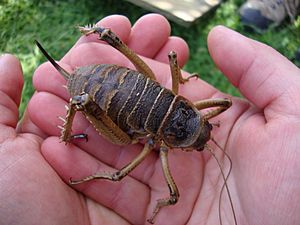Cook Strait giant weta facts for kids
Quick facts for kids Cook Strait giant weta |
|
|---|---|
 |
|
| Cook Strait giant weta from Matiu / Somes Island | |
| Conservation status | |
|
Invalid status (NZ TCS)
|
|
| Scientific classification | |
| Genus: |
Deinacrida
|
| Species: |
rugosa
|
The Deinacrida rugosa, also known as the Cook Strait giant weta, is a very large insect. It belongs to the family Anostostomatidae. Its scientific name, Deinacrida, means "terrible grasshopper". The word rugosa means "wrinkled". This amazing insect is found only in New Zealand.
Contents
What is a Cook Strait Giant Weta?
The Cook Strait giant weta is one of the biggest insects on Earth. It can grow up to 7 centimetres (2.8 in) long. Imagine an insect as long as your palm!
Appearance
This weta has a brownish-yellow body. It looks very strong and is covered in thick, overlapping plates. These plates have black marks on them. Its jaws are quite big compared to its head. Its back legs are long and have five or six large spikes. The weta can lift these spiky legs over its head to defend itself. Female wetas are much larger than males. Neither males nor females have wings.
Where Do They Live?
The Cook Strait giant weta lives only in New Zealand. You can find them on several islands. These include the North, South, and Middle Trio islands. They also live on Stephens, Maud, Matiu/Somes, and Mana islands.
In 2007, these wetas were brought back to mainland New Zealand. They had been gone from the mainland for over 100 years. Now, you can find them in the Zealandia Wildlife Sanctuary. This sanctuary is on the North Island. These wetas like to live in open grasslands, bushy areas, and the edges of forests.
How Do They Live?
The Cook Strait giant weta is active at night. This means it is a nocturnal animal. It eats parts of plants that grow above the ground.
Daily Life
During the day, the weta hides. It might make a temporary shelter in the soil. It also hides under dead leaves, tree bark, or stones. After the sun sets, it comes out to look for food. It forages on the ground or on small bushes. It especially likes the flowers of a plant called tauhinu (Cassinia leptophylla).
Reproduction
Cook Strait giant wetas live alone and move around a lot. For them to have babies, the male weta needs to find a female. They have a strong scent that helps the male find a female. Their droppings also have a strong smell. A male weta might travel over 250 meters in one night to find a female!
Once a male finds a female, he puts a leg over her body. He stays in contact with her until they find a safe place to hide during the day. They mate during the day. If the weather is cool and wet, they might even mate through the night. After mating, the female lays about 200 eggs in the soil. Then, she dies. The eggs grow for a few months. They hatch in the spring. The young wetas look like tiny adults. It takes most of their two-year life to grow to full size. They grow by shedding their skin about nine times over 12 to 18 months.
Dangers and Protection
Many animals hunt the Cook Strait giant weta. These include birds and reptiles like the tuatara. When a weta feels threatened, it has a special defense. It raises its spiky legs over its head. It waves them up and down. It also makes a hissing sound by rubbing its body plates together.
Past Threats
Long ago, Cook Strait giant wetas lived on mainland New Zealand. But then, new animals like the black rat (Rattus rattus) arrived. These rats hunted the wetas. Also, much of the weta's habitat was destroyed. This caused the weta's population to shrink. They could only be found on a few small islands that had no rats.
Because wetas live on the ground, are large, and have a strong scent, they are easy targets for predators. If new predators accidentally get onto the islands, it could be very bad for the wetas.
Conservation Efforts
People are working hard to protect the Cook Strait giant weta. They have moved wetas to new islands. In 1976, they were moved to Mana Island. In 1996, they went to Matiu / Somes Island. Most recently, in 2007, they were moved to Zealandia Wildlife Sanctuary. These efforts have helped the species grow its population.
On Mana Island, people removed cattle and got rid of mice. This helped the weta population grow a lot. The New Zealand Department of Conservation plans to keep moving wetas to new island homes. They also make sure the current island homes are safe from predators.
In 1996, 62 wetas were moved from Mana Island to Matiu-Somes Island. Scientists checked on the wetas there in 2013 and 2015.
At Zealandia Wildlife Sanctuary, a special fence keeps out animal predators. The sanctuary hopes to create an environment like New Zealand had before humans arrived. This way, animals like the Cook Strait giant weta can thrive again.
The Department of Conservation says the Cook Strait giant weta is "At Risk: Relict." This means its population is stable but still small.
Images for kids



